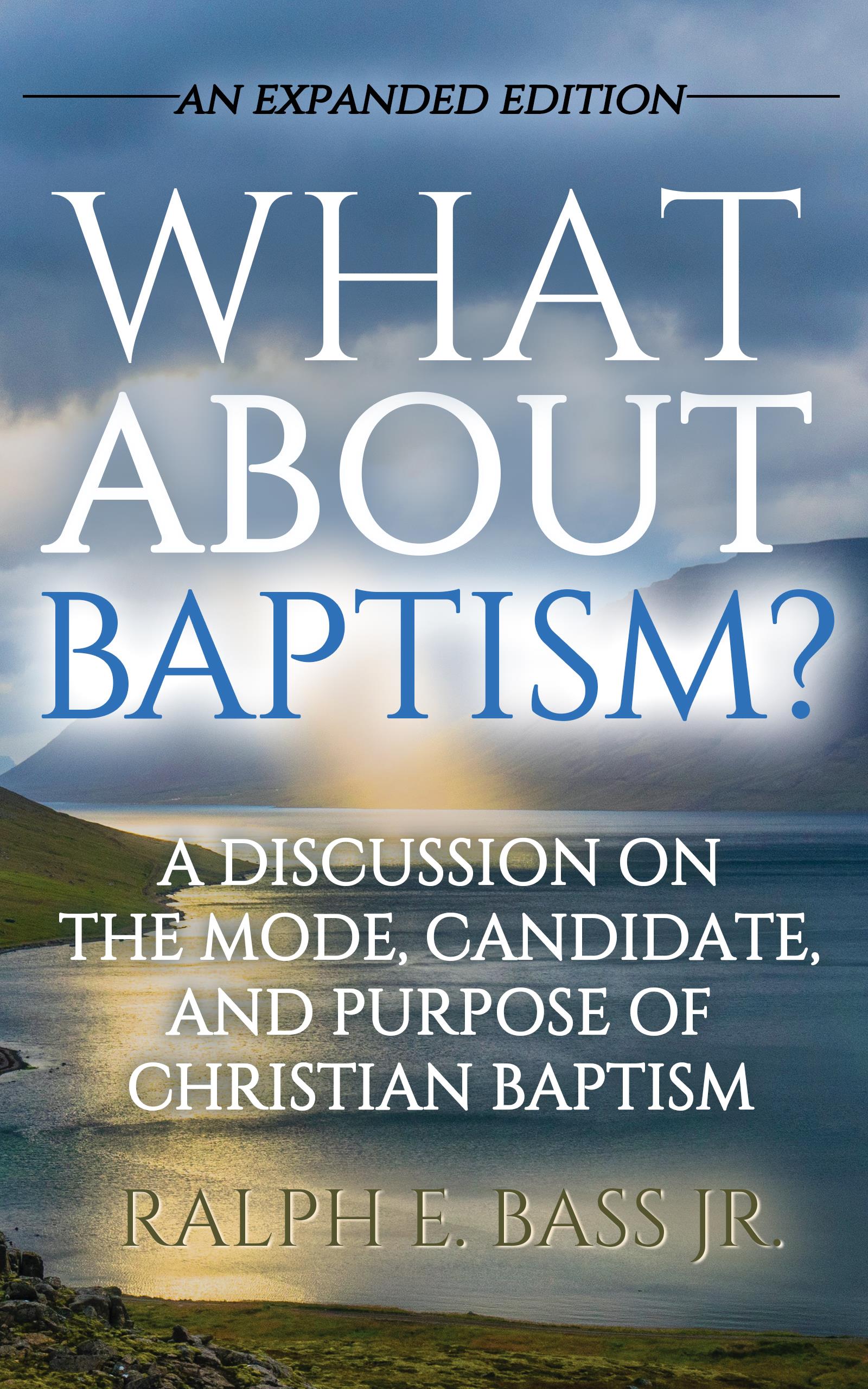
Hi, My Name Is Ralph Bass...This Is My Library


Subscribe to this Site
Baptizing Furniture
As you can see, the New Testament writers, Mark (a Jew) and Luke (a Greek), call these procedures ceremonial washings—the Greek word is baptizo. This washing, or baptism in water , was of people and furnishings. Now does any sane man think that this Pharisee really expected Jesus to dip his whole body in water before each meal? I suppose there are people that would make that claim if they thought they had to in order to maintain their commitment to dipping!
This Pharisee and others in that period obtained their instructions on how to properly wash from the Old Testament:
“And a clean person shall take hyssop and dip it in the water, and sprinkle it on the tent and on all the furnishings and on the persons who were there….” Numbers 19:18
“An officer of the king of Israel answered, ‘Elisha son of Shaphat is here. He used to pour water on the hands of Elijah.’” II Kings 3:11
As one author tells us, “Before meals were eaten the hands were always washed under running water because there were no utensils such as knives, forks, and spoons. In a wealthy home, this task would be performed by a servant.”[1] The practice was universal in the Near East; one scholar “…speaking of a Persian supper, says, ‘Supper being now brought in, a servant presented
Let's Look Inside
the Book


Baptism in Water -
The religious leaders especially, and most of the Jews in general, were careful about following the dictates of The Law in the practice of daily living. One of those requirements was the ceremonial cleansings of people after they went to the market. Note these Scriptures:
“…and when they come from the market place, they do not eat unless they cleanse (baptizo) themselves; and there are many other things which they have received in order to observe, such as the washing (baptismos) of cups and pitchers and copper pots.” Mark 7:4
“Now when He had spoken, a Pharisee asked Him to have lunch with him; and He went in, and reclined at the table. And when the Pharisee saw it, he was surprised that He had not first ceremonially washed (baptidzo) before the meal.” Luke 11:37-38
a basin of water, and a napkin hung over his shoulders; he went to every one in the company, and poured water on their hands to wash’.”[2] Another writer says, “…the hands were held with finger tips pointing upwards; water was poured over them and had to run at least down to the wrist….”[3] “This was not a matter of hygiene. It had nothing to do with germs. It was a matter of fear of ceremonial defilement…. Also, although it is true that for ‘ceremonially washed’ the original uses a form of the verb to baptize, it is clear that in the present context this verb cannot very well refer to the immersion of the entire body. It refers, of course, to the already indicated act of pouring water over the hands.”[4]
Based on these facts, we must conclude that Baptidzo, used in the first part of Mark 7:4 and in Luke 11, has reference to a hand washing in running water by pouring, a baptism in water.
From this we can also see that even though only the hands were baptized, it was nevertheless a baptism. In other words, the whole body does not need to be baptized for the Bible to consider a baptism in water to have taken place. Obviously, this is an important point when we consider Christian baptism. Many believe that the whole body must be covered or no baptism in water has taken place. Clearly, this passage testifies to the serious error of that position.
In addition, it is significant that Baptidzo is used here without adjuncts—explanatory words. We simply read, “The Pharisee was astonished to see that he did not first wash (Baptidzo) before dinner.” And “…they do not eat unless they wash (Baptidzo). The speakers and the writers knew perfectly well that their audience understood that by such a statement they meant, “to purify ceremonially.” Such usage demonstrates how common it was to speak of a ceremonial cleansing as a Baptidzo. Without adjuncts, the meaning is lost, unless this use was in such widespread practice that it was perfectly clear to the audience.
The Old Testament is clear; these ceremonies were rendered by sprinkling or pouring. So, therefore again, the New Testament uses the word sprinkle or pour to describe a baptism in water.
Again, although the pots and cups may have been dipped at these times, it is inconceivable that people dipped themselves every time they went to the market. Actually, the average person of that day bathed only a few times a year, which helps explain the constant allusions to perfumes in the New Testament.
So, notice in particular that people are identified here as baptized in water by sprinkling.
-----------------------------------------------------------------
[1] Gower, R., & F. Wright. The New Manners and Customs of Bible Times. Chicago: Moody Press, 1997, c1987.
[2] The Treasury of Scripture Knowledge: Five Hundred Thousand Scripture References and Parallel Passages. Oak Harbor: Logos Research Systems, Inc., 1995. 2 Ki 3:11.
[3] The Gospel of Mark. Ed. W. Barclay, lecturer in the University of Glasgow. The Daily study Bible series, Rev. ed. Philadelphia: The Westminster Press, 2000, c1975.
[4] Hendriksen, W., & S. J. Kistemaker. New Testament Commentary: Exposition of the Gospel According to Luke. New Testament Commentary. Grand Rapids: Baker Book House, 1953-2001. Page 637.
Based on these facts, we must conclude that Baptidzo, used in the first part of Mark 7:4 and in Luke 11, has reference to a hand washing in running water by pouring, a baptism in water.
From this we can also see that even though only the hands were baptized, it was nevertheless a baptism. In other words, the whole body does not need to be baptized for the Bible to consider a baptism in water to have taken place. Obviously, this is an important point when we consider Christian baptism. Many believe that the whole body must be covered or no baptism in water has taken place. Clearly, this passage testifies to the serious error of that position.
In addition, it is significant that Baptidzo is used here without adjuncts—explanatory words. We simply read, “The Pharisee was astonished to see that he did not first wash (Baptidzo) before dinner.” And “…they do not eat unless they wash (Baptidzo). The speakers and the writers knew perfectly well that their audience understood that by such a statement they meant, “to purify ceremonially.” Such usage demonstrates how common it was to speak of a ceremonial cleansing as a Baptidzo. Without adjuncts, the meaning is lost, unless this use was in such widespread practice that it was perfectly clear to the audience.
The Old Testament is clear; these ceremonies were rendered by sprinkling or pouring. So, therefore again, the New Testament uses the word sprinkle or pour to describe a baptism in water.
Again, although the pots and cups may have been dipped at these times, it is inconceivable that people dipped themselves every time they went to the market. Actually, the average person of that day bathed only a few times a year, which helps explain the constant allusions to perfumes in the New Testament.
So, notice in particular that people are identified here as baptized in water by sprinkling.
-----------------------------------------------------------------
[1] Gower, R., & F. Wright. The New Manners and Customs of Bible Times. Chicago: Moody Press, 1997, c1987.
[2] The Treasury of Scripture Knowledge: Five Hundred Thousand Scripture References and Parallel Passages. Oak Harbor: Logos Research Systems, Inc., 1995. 2 Ki 3:11.
[3] The Gospel of Mark. Ed. W. Barclay, lecturer in the University of Glasgow. The Daily study Bible series, Rev. ed. Philadelphia: The Westminster Press, 2000, c1975.
[4] Hendriksen, W., & S. J. Kistemaker. New Testament Commentary: Exposition of the Gospel According to Luke. New Testament Commentary. Grand Rapids: Baker Book House, 1953-2001. Page 637.
















































































































